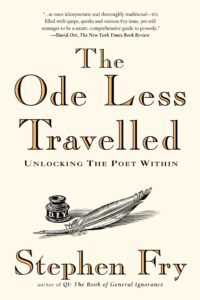Stephen Fry on Form, Part 8
 As I mentioned previously, I’m working through Stephen Fry’s The Ode Less Travelled very slowly to absorb as much wisdom as I can about writing poetry. This week’s post covers Chapter 3, Section 8, on comic forms.
As I mentioned previously, I’m working through Stephen Fry’s The Ode Less Travelled very slowly to absorb as much wisdom as I can about writing poetry. This week’s post covers Chapter 3, Section 8, on comic forms.
This section only covers three forms, and I would argue that the first of them doesn’t have to be comic in nature. The forms are the cento, the clerihew, and the limerick.
The cento is created by taking lines from other poems and putting them together like a collage. It can be done to comic effect, but it doesn’t have to be. There are also a lot of other rules that the book does not cover, such as aiming to use lines of similar length, often to give them a rhyme scheme of some sort, and more. The end result, though, can be pretty cool–I “wrote” my first sonnet by pulling lines from other sonnets into a cento sonnet that works surprisingly well.
The clerihew is a simple form that begins with a person’s name, says a little bit about them in the remaining four lines (rhymed aa bb), and has ZERO metrical cohesion. In fact, it’s important that it doesn’t wind up falling into a metrical pattern to be a proper clerihew. They generally wind up a little silly, too. This one is new to me!
Finally, the limerick is probably the form that most children learn soon after nursery rhymes, and it’s almost always used for comic effect, if not outright vulgar effect.
The remainder of this section talks about comic and impolite verse, light verse, and parody, all in a way of getting across the point that poetry does not have to be serious, philosophical, or otherwise high brow to be good. The exercise in this section is to write a parody of a favorite poem or a cento, and having done both (variations on “This is Just to Say” are some of my favorite internet poems), I decided to skip the exercise.
Next up is “exotic” forms, which seems to largely mean “forms from East Asia.”

Comments